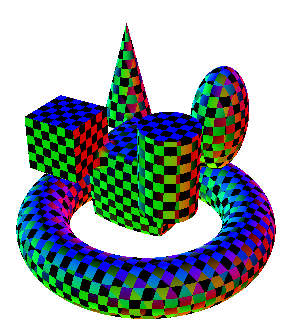Woah!!!!!!!! That is exciting!!!!
On Sat, May 19, 2018 at 5:10 AM, TLC123 notifications@github.com wrote:
When creating textures (x,y,z,t) is available to plug in to some function. In Shadertoy there are many examples where, in addition to the (x,y,z,t) coordinate, the normal of the field at that (x,y,z,t) point is made available. This is of course very useful for texture generation I hacked up a thing like this [image: alt text] https://github.com/TLC123/Curv_stuff/blob/master/rgbn.png?raw=true
the code let
RGB_normal shape =
make_shape { dist p : shape.dist(p), colour p : let n= ( ( normalize( (shape.dist(p) - shape.dist(p+(0.001,0,0,0)) ) , (shape.dist(p) - shape.dist(p+(0,0.001,0,0)) ) , (shape.dist(p) - shape.dist(p+(0,0,0.001,0)) ) ))); in max(0,n[X])*[0,1,1]+max(0,n[Y])*[0,1,0]+max(0,n[Z])*[1,1,0]+ -min(0,n[X])*[1,0,0]+-min(0,n[Y])*[1,0,1]+-min(0,n[Z])*[0,0,1] , bbox : shape.bbox, is_2d : shape.is_2d, is_3d : shape.is_3d,};
in
union( smooth 0.2 .union( union( ellipsoid (1,1.4,2) >>move(1,1,1) , cone {d:1, h:2}>>move(-1,1,0.5), cylinder {d:1, h:1.5}>>move(1,-1,1), cube 1>>move(-1,-1,1) ), morph 0.75 ( sphere 2 , cube 1.45>>offset 0.05), ), torus {major:4, minor:1}>>move(0,0,-1)
)
RGB_normal
— You are receiving this because you are subscribed to this thread. Reply to this email directly, view it on GitHub https://github.com/doug-moen/curv/issues/19, or mute the thread https://github.com/notifications/unsubscribe-auth/AQWpJX7p9JrgSSMzs4PifdYzZr9ZGL4cks5tz-GFgaJpZM4UFo9J .
-- Do you want to make something? Here are the tools. Go
Diyode is the single most awesome toy under the tree at Christmas that I had to grow up to get

When creating textures (x,y,z,t) is available to plug in to some function. In Shadertoy there are many examples where, in addition to the (x,y,z,t) coordinate, the normal of the field at that (x,y,z,t) point is made available. This is of course very useful for texture generation I hacked up a thing like this https://www.shadertoy.com/view/ld3BDj
the code
let
https://www.shadertoy.com/view/ld3BDj
the code
let